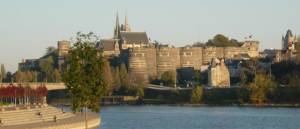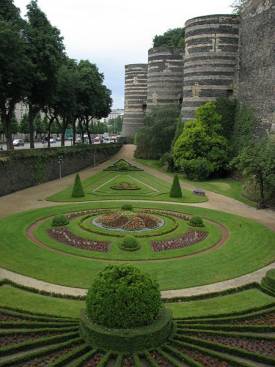Angers Chateau
 Of
all the Loire Valley châteaux, Angers is the least 'prettified'.
Blois, Amboise, Sully and Villandry may have had medieval origins,
but the Renaissance-influenced rebuilding in the sixteenth century
gives them the appearance of royal pleasure-palaces. At Angers, it's
the other way round. There was rebuilding, but it still looks like a
serious piece of medieval fortification, designed to repel invaders.
Indeed, throughout France's long and turbulent history, the Châteaux
d'Angers has never fallen to a siege.
Of
all the Loire Valley châteaux, Angers is the least 'prettified'.
Blois, Amboise, Sully and Villandry may have had medieval origins,
but the Renaissance-influenced rebuilding in the sixteenth century
gives them the appearance of royal pleasure-palaces. At Angers, it's
the other way round. There was rebuilding, but it still looks like a
serious piece of medieval fortification, designed to repel invaders.
Indeed, throughout France's long and turbulent history, the Châteaux
d'Angers has never fallen to a siege.
Ok so it fell to the Romans in about 80 BC, but 'castle' the Andecavi were defending only had wooden fences, and even so, the Andecavi put up a good fight. The rocky ridge overhanging the river Maine makes an ideal site for a castle, and building, demolition and more building have gone on there for the last two thousand years. The Counts of Anjou had a castle there in the ninth century, which later became part of the Angevin empire of the Plantagenet Kings of England. Philip II took the region back from the English in 1204, and his grandson Louis IX began work on the Château we see today.

Louis is the only French King to have been promoted to Saint (as in Saint
Louis, Missouri.) Pious he may have been, but he wasn't taking any chances with
his new castle. The vast walls are 600m in circumference, encompass more than 6
acres and are protected by seventeen massive towers. More building followed in
the Medieval period, including the Sainte Chapelle. A Sainte Chapelle (as
opposed to an ordinary chapel) has to have a relic of the Passion, and the
Angers Chapelle had a piece of the True Cross. (Apparently, the Empress Helena
had found all three crosses in a church basement in about 300 AD, and the
identity of the True Cross was revealed to her in a miracle. Which was handy.)
By 1562, Angers was looking a bit shabby, so Catherine de Medici re-fortified it. Her son Henri III then de-fortified it, demolished the tops of the towers and used the stones for property development in the town. When the Hugenots attacked, there wasn't time to get all the stones back, so Henri installed artillery on the château terraces instead. He then got bored of Angers and ordered its demolition, which continued until his successor, also Henri, called a halt.
Angers in the Revolution
Angers was re-fortified in the Revolution and came under attack from the counter-revolutionary Vendean army, who launched a massive bombardment against the castle walls. When the smoke cleared, and they saw they'd made no impact whatsoever, they packed up and went home. Angers then became a Napoleonic Military Academy, which, ironically, trained Arthur Wellesley, Duke of Wellington. The castle suffered its last major damage under German occupation, when it served as a munitions dump, and exploded.
Besides the awe-inspiring battlements, Angers boasts the historic Tapestry of the Apocalypse (begun in 1373) which is 100m long and illustrates the Revelation of St John. The Château is open all year round (except 1st Jan, 1st May, 11th Nov and 25th Dec) and admission costs 7€.